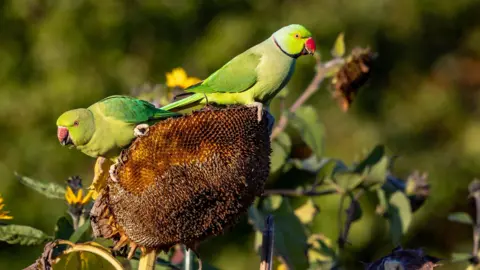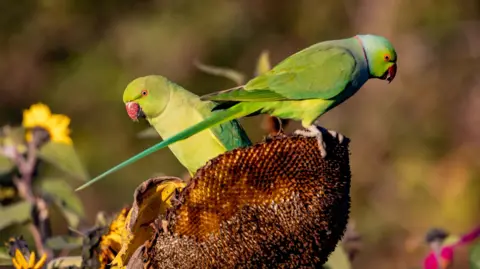Colourful parakeets have been spotted for what is thought to be the first time in a Cambridgeshire orchard.
The exotic birds have made a new home for themselves in Coton.
Anna Gazeley, whose family runs Coton Orchard, established in 1922, said it was "the first time we've seen [the birds] in Cambridge".
The green ring-necked parakeets, or Psittacula krameri, are not native to this country but are the UK's only naturalised parrot, and the most northerly breeding parrot in the world, according to the local Wildlife Trust.
The Wildlife Trust for Bedfordshire, Cambridgeshire and Northamptonshire said the birds would initially have escaped from owners or zoos and become established in the UK.
Colonies have been seen for decades in London, such as Richmond Park, and the south-east of England.
The parakeets are originally from Africa and southern Asia and were kept as pets in the UK.
They escaped into the wild and have become naturalised, aided by warmer winters, the trust said.
They nest in holes in trees in gardens and parkland, and are often found in noisy, roosting flocks of hundreds. They eat nuts, seeds, berries and fruits.
 Anna Gazeley
Anna Gazeley Anna Gazeley
Anna GazeleyThe birds have been spotted in various places including Peterborough, and as far north as Scotland.
However, it is perhaps a first for the Cambridge area.
Bridget Sutton, from community project Coton Loves Pollinators, said she heard the parakeets before she saw them, but when she did, she "couldn't quite believe my eyes".
"I thought, no, they don't belong here. I was a bit surprised to hear squawking and I thought, hang on, that sounds like a parrot," she said.
Ms Gazeley said: "It was surreal - a bit like being in a Disney episode to see this very exotic bird on top of a sunflower.
"It's got brilliant green plumage, this rose-pink ring round its neck and a blue hue down its back - it's a really lovely bird."
It is not known how the parakeets came to establish their wild colonies, but according to the Natural History Museum, reports of them in our countryside began to emerge in the late 19th Century.
Since the 1990s, the birds have established themselves first in the capital and south-east of England, and then moved further afield.
According to the museum, "urban myths" about how they came to populate parts of the UK include the birds escaping from the set of the 1951 film The African Queen, filmed in West London, and that musician Jimi Hendrix released a pair on Carnaby Street, in the centre of the capital.
However, it was, they said, more likely that intentional releases led to the colonies we now have.
The museum added: "In the early 1930s and again in the 1950s, 'parrot fever' made headline news... with cases of bird owners catching psittacosis - a respiratory disease that can result in pneumonia and can jump from birds to people.
"The Ministry of Health banned the import of birds for 20 years and scientists suspect pets may have been released by fearful owners or dodgy pet traders during this time."
Ms Gazeley said: "The parakeets are quite adaptable and have clearly found a home in Britain."
Asked about the potential of a "parakeet invasion" of the rest of Cambridgeshire, she said: "I'm not worried - so long as Coton Orchard stands, there's loads of fruit and plenty to share.
"I don't think they're going to be pushing out any of our local birds."
Follow Cambridgeshire news on BBC Sounds, Facebook, Instagram and X.

.jfif)
Post a Comment